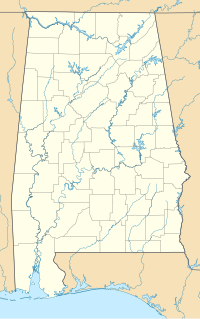Spring Hill (Mobile, Alabama)
| Spring Hill | |
|---|---|
| Neighborhood of Mobile, Alabama | |

Stewartfield (1850), one of several surviving antebellum summer houses, and its avenue of live oaks.
|
|
| Location within the state of Alabama | |
| Coordinates: 30°41′55″N 88°08′20″W / 30.69852°N 88.13889°W | |
| Country | United States |
| State | Alabama |
| County | Mobile |
| City | Mobile |
| Elevation | 184 ft (56 m) |
| Time zone | Central (CST) (UTC-6) |
| • Summer (DST) | CDT (UTC-5) |
| ZIP code | 36608 |
| Area code(s) | Area code 251 |
| Website | The Village of Spring Hill |
Spring Hill is an affluent neighborhood of Mobile, in Mobile County, Alabama. Located on a tall broad hill 6 miles (10 km) to the west of downtown Mobile, it has one of the highest elevations in the area. Originally a summer retreat community, it was eventually encompassed and annexed by the City of Mobile after 1820. It gained its name from a number of natural springs at the site.
Overlooking the surrounding landscape, Spring Hill began to be extensively settled in the first half of the 19th century. Among its first inhabitants were former French Bonapartists from the failed Vine and Olive Colony in Marengo County, Alabama. With Alabama statehood in 1819, during the 1820s, the city of Mobile and private developers bought what became Spring Hill. Between 1820 and 1827, the government of Mobile purchased three-fourths of section 14 from the U.S. Congress. In 1828 William Robertson acquired all of section 13 (640 acres or 260 ha) and had a plat drawn up of 121 5-acre (2.0 ha) lots, sold at the rate of $100 per acre ($250/ha). Joshua Collins acquired 120 acres (49 ha) of another section and subdivided 80 acres (32 ha) of it into 10-acre (4.0 ha) lots. At the time, the majority of the land surrounding Mobile, outside of what is now downtown, was mosquito-infested swamp. With the city plagued by extreme humidity, heat, rain, and yellow fever epidemics during the warm months, people began to realize that the western hills outside of the city tended to remain relatively free of fever and disease. Many wealthy Mobilians soon built summer residences on lots in Spring Hill. The earliest houses of the 1830s and 1840s tended to be cottages, with many in the Gulf Coast cottage style. Large country houses in the Greek Revival style came to dominate by the 1850s and later.
Michael Portier, the Roman Catholic Bishop of Mobile, purchased 300 acres (1.2 km2) in Spring Hill in 1830 for the establishment of Spring Hill College, initially a Jesuit seminary and boarding school. It is the oldest institution of higher education in Alabama, the oldest Catholic college in the South and fifth oldest in the United States. In January 1832, construction began on an aqueduct of cast iron and wooden pipes to bring water into Mobile from a spring on the hill. It became the Mobile Aqueduct Company, the forerunner of what is today the Mobile Area Water and Sewer System.
...
Wikipedia

